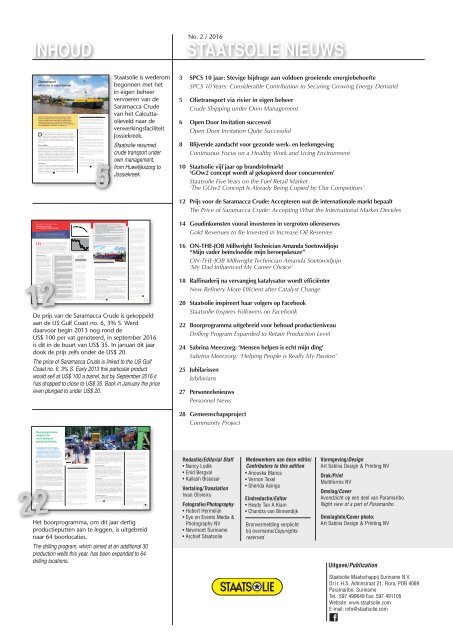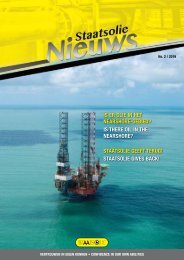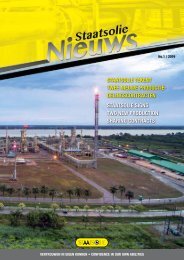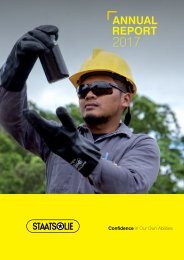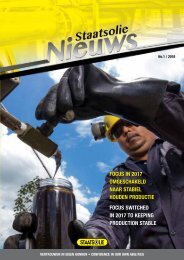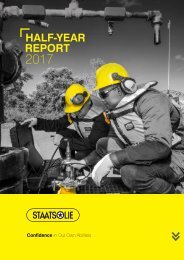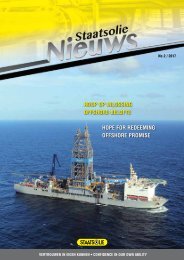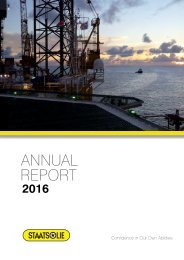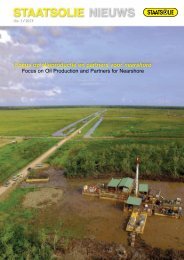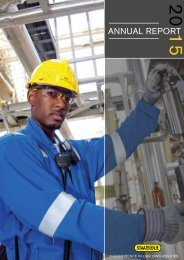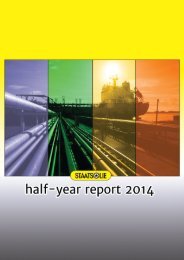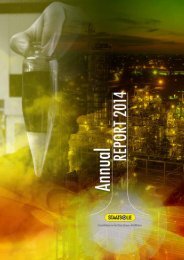Staatsolie Nieuws Oktober 2016
Create successful ePaper yourself
Turn your PDF publications into a flip-book with our unique Google optimized e-Paper software.
Developments<br />
The growing demand necessitated three<br />
expansions of the SPCS power plant in<br />
the past ten years. In 2010 the generating<br />
capacity was doubled to 28 MW, followed<br />
by another expansion to 62 MW<br />
in 2014. The final expansion to 96 MW<br />
was in 2015.<br />
‘These expansions have constantly<br />
contributed to guaranteeing the energy<br />
supply for the Greater Paramaribo grid’,<br />
Eddy Fränkel, SPCS Managing Director<br />
says, emphasizing the plant’s significance<br />
for the country. The Energy Act, which<br />
was adopted earlier this year, will see<br />
to restructuring of the energy sector<br />
in Suriname. One of the results of this<br />
restructuring is that independent electricity<br />
producers such as SPCS will have more<br />
opportunities to invest in energy supply.<br />
‘By that time SPCS will certainly make a<br />
bid on installing additional power’, Eddy<br />
says. The Tout Lui Faut power plant has<br />
ample space for expansion with an additional<br />
34 MW. Certain facilities such as<br />
fuel storage tanks are already in place.<br />
Thermal Energy<br />
Eddy explains the most important<br />
aspects of the SPCS cogeneration<br />
power plant. A cogeneration power<br />
plant produces electricity, while using<br />
the waste heat to produce steam for<br />
example. The generators in the power<br />
plant use fuel oil from the refinery. The<br />
generated power is supplied to the refinery<br />
and via the government to the EBS.<br />
Combustion of fuel oil produces a lot of<br />
heat, which is turned into steam. The<br />
steam in turn is delivered to the refinery<br />
for the treatment of Saramacca Crude.<br />
ctieproces<br />
Skilled Operators<br />
production process. SPCS is managed by Eddy Fränkel and<br />
Arnie Kleiboer. Both men are happy<br />
the factory can make a contribution<br />
to society’s needs. Arnie: ‘With SPCS <strong>Staatsolie</strong> has a tool<br />
for reliable supply of electricity to the refinery. If the refinery<br />
would be down because of a blackout, it would take four to<br />
five days to get it up and running again, which in turn would<br />
affect the fuel production.’<br />
From the SPCS control room operators monitor the production<br />
process. Fränkel is proud of his team. ‘These are<br />
the people who do the real work. We have an entirely<br />
Surinamese crew, none of whom had previous experience<br />
in a power plant. However, through training they have been<br />
equipped to work in our thermal power plant. Now they are<br />
all fully qualified and skilled operators and mechanics!’<br />
van de bedrijfsbrede bezuinigingsmaatregelen die vanaf 2015 worden<br />
uitgevoerd. Gedurende 10 jaren werd het olietransport uitgevoerd door<br />
een contractor.<br />
Het zogenoemde bargen in eigen beheer vindt plaats in afwachting van<br />
de oplevering van de 13 kilometer lange pijplijn tussen Calcutta en Tambaredjo<br />
Noord-West (TNW). “Wanneer die pijplijn bedrijfsklaar is, zal de<br />
olie die Calcutta produceert via TNW worden verpompt naar TA58. Daar<br />
vindt de verwerking plaats en vervolgens wordt de olie naar de raffinaderij<br />
verpompt”, legt Production Asset Manager Patrick Brunings het proces uit.<br />
Inmiddels is ook het herstel van de door corrosie aangetaste testtanks op<br />
Calcutta begonnen. Door de <strong>Staatsolie</strong> IV, een tanker met een grotere<br />
capaciteit, wordt voldoende vrije ruimte gecreëerd voor de operatie te Calcutta,<br />
waardoor die werkzaamheden vlot uitgevoerd kunnen worden.<br />
De <strong>Staatsolie</strong> IV heeft in de afgelopen twintig jaren gefungeerd als bunkerschip<br />
voor internationale schepen met als thuishaven Tout Lui Faut. Er<br />
is negen uur over gedaan om het schip naar de aanmeersteiger op Huwelijkszorg<br />
over zee te varen. De olietanker is 63 meter lang, 12 meter breed<br />
en heeft een diepgang van 4 meter. De maximale laadcapaciteit is 8000<br />
barrels, ruim 1,2 miljoen liter.<br />
Tal van factoren bepalen de olieprijs op de wereldmarkt. De belangrijkste:<br />
• De stand van de wereldeconomie.<br />
• De invloed van de OPEC. Niet meer zo machtig als vroeger, maar wanneer de<br />
OPEC een bepaalde streefprijs, een productieverlaging of -uitbreiding aankondigt,<br />
dan is dat vaak direct te merken aan de olieprijs.<br />
Crude does not have its own price. The produced<br />
• De waarde van de Amerikaanse dollar. De prijs van olie en andere grondstoffen<br />
quantities, an average of 17,000 barrels a day, are too<br />
(commodities) wordt in dollars uitgedrukt. Een verandering in de waarde van de<br />
low to mean something on the international market.<br />
dollar heeft direct invloed op de olieprijs.<br />
The biggest part of the produced Saramacca Crude<br />
• Ontwikkelingen in de olie-industrie (productie, raffinage en reserves), geopolitiek<br />
De prijs van de Saramacca Crude is gekoppeld aan de US Gulf<br />
en zelfs geruchten.<br />
(15,000 barrels) is processed in the <strong>Staatsolie</strong><br />
Coast no. 6, 3% S. Werd daarvoor begin 2013 nog rond de<br />
refinery to produce mainly premium diesel, premium<br />
Various factors determine the oil price on the world market. These are the most important ones:<br />
gasoline and bitumen. The diesel and gasoline are<br />
US$ 100 per vat genoteerd, in september <strong>2016</strong> is dit in de buurt<br />
• The status of the global economy.<br />
ultra-low sulphur products. Refining Saramacca<br />
van US$ 35. In januari dit jaar dook de prijs zelfs onder de US$ 20.<br />
• The OPEC no longer is an influential as in former days. However, when OPEC decides on a target<br />
price, production cut or production increase, the oil price is often immediately affected.<br />
Crude to high quality products adds much value to it.<br />
• The value of the American dollar. Like every other commodity oil is quoted in dollars. A change in<br />
<strong>Staatsolie</strong> exports the remaining part. Depending on<br />
value of the American dollar immediately affects the oil price.<br />
the demand, the company exports between 185,000<br />
• Developments in the oil industry (production, refining and reserves), geopolitics and even rumors.<br />
and 285,000 barrels Saramacca Crude a month to<br />
Guyana, Barbados and Trinidad & Tobago.<br />
Margins<br />
Although Saramacca Crude has a lower sulfur content<br />
<strong>Staatsolie</strong> op gang en werd in de Suralco een klant gevonden. Suralco gebruikte<br />
than the US Gulf Coast, <strong>Staatsolie</strong> cannot demand a<br />
onze ruwe olie als vervanging van importstookolie met een zwavelgehalte (S) van<br />
higher price for its product. ‘The market decides the<br />
3%. De Saramacca Crude is een zware olie met een laag zwavelgehalte (0,7%)<br />
sulfur content’, Leon Brunings, manager Marketing<br />
en kan vanwege deze specifieke eigenschap zonder verwerkt te worden als<br />
explains. Before 1 January 2015, the criterion for<br />
stookolie worden verkocht. Suralco kocht dus onze olie tegen de referentieprijs<br />
the bunkering market was that fuel oil should have a<br />
voor de US Gulf Coast no. 6, 3% S.<br />
maximum sulfur content of 1 percent. ‘With its sulfur<br />
content of 0.7 percent, Saramacca Crude was much<br />
Waarde toegevoegd<br />
The Price of<br />
in demand and <strong>Staatsolie</strong> could exceed the target<br />
Wereldwijd is er niet slechts één algemene prijs<br />
<strong>Staatsolie</strong> heeft te accepteren wat de<br />
voor ruwe olie, omdat er meerdere soorten zijn,<br />
Saramacca Crude:<br />
price. After 1 January 2015 when the criterion was a<br />
internationale markt bepaalt. In tegenstelling<br />
tot bijvoorbeeld de West Texas worden benchmark-prijzen (referentieprijzen) International Market Decides<br />
ger in demand and the margins became less. Since<br />
sommige meer gewild dan andere. Daarom<br />
Accepting What the<br />
maximum of 0.1 percent sulfur, our crude was no lon-<br />
gebruikt. Dit zijn de belangrijkste referentie-oliesoorten:<br />
De King Fisher in de haven van Tout Lui Faut. Met deze tanker<br />
Intermediate en de Brent (twee andere<br />
the bunkering market demands 0.1 percent sulfur,<br />
typen ruwe olie) heeft de Saramacca<br />
The price of Saramacca Crude is<br />
wordt olie naar klanten in het Caribisch gebied vervoerd.<br />
we have reached that demand with our premium<br />
Crude geen eigen prijs. De geproduceerde<br />
hoeveelheden, gemiddeld<br />
S. Early 2013 this particular product<br />
Brent<br />
linked to the US Gulf Coast no. 6, 3%<br />
The King Fisher at the jetty at Tout Lui Faut. With this tanker oil is<br />
diesel. And business is booming.’ Power plants in<br />
Brent refereert naar olie afkomstig van verschillende<br />
olievelden in de Noordzee. Deze olie is<br />
shipped to customers in the Caribbean.<br />
French overseas departments still use the 0.7 percent<br />
17.000 barrels per dag, zijn te klein om licht en zoet en heel geschikt voor het maken van would sell at US$ 100 a barrel, but<br />
criterion and the margins on the price for the oil they<br />
in de wereld enig gewicht in de schaal benzine en diesel.<br />
by September <strong>2016</strong> it has dropped<br />
purchase are very good.<br />
te leggen.<br />
WTI<br />
to close to US$ 35. In January this<br />
voor schepen) dat stookolie een zwavelgehalte van maximaal 1 % mocht hebben.<br />
Het grootste deel (15.000 barrels) van West Texas Intermediate (WTI) refereert naar year the price even plunged to under<br />
“Met een zwavelgehalte van 0,7% was de Saramacca Crude heel erg in trek en<br />
Global Challenges<br />
de geproduceerde Saramacca Crude<br />
ruwe olie afkomstig uit olievelden in de Verenigde US$ 20.<br />
kon <strong>Staatsolie</strong> een hogere marge boven op de richtprijs doorberekenen. “Na 1<br />
In 2015 Saramacca Crude sold at an average price<br />
Staten. De WTI is zeer lichte en zoete olie heel<br />
wordt in onze eigen raffinaderij verwerkt<br />
tot voornamelijk premium die-<br />
US Gulf Coast no. 6, 3% S is a type<br />
interessant was voor de bunkermarkt. De marges werden toen kleiner. Aangezien 2014. The drop in oil price caused <strong>Staatsolie</strong> gross<br />
januari 2015 werd de eis maximaal 0,1% zwavel, waardoor onze olie niet meer<br />
of US$ 44.48 per barrel, compared to US$ 85.34 in<br />
geschikt voor de productie van benzine.<br />
sel, premium gasoline en bitumen. De OPEC<br />
of fuel oil. It may sound strange that<br />
de bunkermarkt nu 0,1% zwavel vereist, hebben wij deze met onze premium<br />
revenues for 2015 (US$ 583 million) to plunge by 45<br />
Voor olie geproduceerd in de OPEC wordt de<br />
diesel en gasoline hebben een zeer<br />
the price of Saramacca crude is<br />
diesel benaderd. En dat gaat goed.” Voor de elektriciteitscentrales in de Franse<br />
percent compared to 2014 when the company earned<br />
OPEC Reference Basket gehanteerd. Dat is een<br />
laag zwavelgehalte (ultra low sulphur). gewogen gemiddelde van de prijzen voor aardolie<br />
geproduceerd door leden van de OPEC. De that link has come about historically.<br />
de stookolie die zij afnemen, zijn goed.<br />
year, <strong>Staatsolie</strong> made a consolidated gross profit of<br />
linked to a product (fuel oil). However,<br />
overzeese gebieden geldt nog de norm van 0,7% en de marges op de prijs voor<br />
US$ 1,056 billion. Despite the somewhat challenging<br />
Door onze ruwe olie tot hoogwaardige<br />
producten te raffineren, wordt er veel<br />
oliesoorten in de OPEC Basket zijn zwaarder dan Back in the 80s of last century, when<br />
US$ 28.9 million (2014: US$ 400 million).<br />
Brent en WTI.<br />
waarde aan toegevoegd. Het deel dat<br />
<strong>Staatsolie</strong>’s commercial oil production<br />
Wereldwijde uitdagingen<br />
Globally the oil industry faced enormous challenges<br />
we niet verwerken wordt geëxporteerd. Globally there is no single general price for crude since<br />
got off the ground, Suralco became<br />
Over 2015 noteerde de Saramaca Crude een gemiddelde prijs van US$ 44,48 per due to the plummeting oil prices. Few had foreseen<br />
Afhankelijk van de vraag gaan er per<br />
there are multiple types of crude, some more in demand<br />
a client. They used the Saramacca<br />
barrel. In 2014 was dat nog US$ 85,34. De daling van de olieprijs zorgde ervoor the steep drop.<br />
maand tussen de 185.000 en 285.000<br />
than others. Therefore, benchmark prices (reference prices) Crude as replacement for the import<br />
dat <strong>Staatsolie</strong>s bruto-omzet over 2015 (US$ 583 miljoen) 45% minder was ten<br />
In the 2015 annual report Managing Director Rudolf<br />
are used. These are the main marker crudes:<br />
vaten Saramacca Crude naar Guyana,<br />
fuel oil with 3 percent sulphur content.<br />
Saramacca Crude is heavy oil<br />
jaar, boekte <strong>Staatsolie</strong> in 2015 een geconsolideerde brutowinst van US$ 28,9 mil-<br />
oil companies in the world, regardless of their size,<br />
opzichte van 2014 (US$ 1.056 miljoen). Ondanks het in vele aspecten uitdagend Elias comments on this: ‘For <strong>Staatsolie</strong> and almost all<br />
Barbados en Trinidad & Tobago.<br />
Brent<br />
Brent refers to crude from different oil fields in the North<br />
with low sulphur content (0.7 %) and<br />
joen (2014: US$ 400 miljoen).<br />
the situation necessitated a careful analysis of the<br />
Sea. This light and sweet crude is ideal for producing gasoline<br />
and diesel.<br />
because of this specific characteristic,<br />
Wereldwijd stond de olie-industrie voor grote uitdagingen vanwege de kelderen-<br />
manner of doing business and a strong focus on the<br />
Marges<br />
Het zwavelgehalte van de Saramacca<br />
it can be sold as fuel oil without treatment.<br />
Suralco, therefore, bought the<br />
In het jaarverslag van 2015 zegt algemeen directeur Rudolf Elias hierover: “Voor<br />
The motto for the years ahead is: ‘We should cut our<br />
de olieprijzen. Slechts weinigen hadden de sterke prijsdaling voorzien.<br />
costs.’<br />
WTI<br />
Crude is lager dan dat van de US Gulf<br />
West Texas Intermediate (WTI) refers to crude oil derived<br />
Coast. Desondanks betekent dit niet dat from oil fields in the United States. WTI crude is very light<br />
Surinamese oil at the reference price<br />
<strong>Staatsolie</strong>, en voor bijna alle oliebedrijven in de wereld ongeacht hun omvang,<br />
coat according to our cloth.’ An austerity plan that<br />
<strong>Staatsolie</strong> een hogere prijs kan vragen<br />
and sweet and very suitable for the production of gasoline. of the US Gulf Coast no. 6, 3% S.<br />
noodzaakte dit een zorgvuldige analyse van de manier waarop zaken worden<br />
took effect early 2015 has helped <strong>Staatsolie</strong> to keep<br />
voor de Saramacca Crude. “De markt<br />
OPEC<br />
gedaan en een sterke focus op de kosten.”<br />
its head above water despite the low oil prices. These<br />
bepaalt wat het vereiste zwavelgehalte<br />
The OPEC Reference Basket (ORB), also referred to as the Adds Value<br />
Het devies voor de komende jaren is: ‘De tering naar de nering zetten’. Een<br />
measures must also see to it that the cost price of<br />
moet zijn”, legt Leon Brunings, manager<br />
Marketing, uit. Vóór 1 januari 2015<br />
national market offers. Contrary to the<br />
olie, ondanks de lage olieprijzen, het hoofd boven water kan houden. De maat-<br />
OPEC Basket, is a weighted average of prices for petroleum <strong>Staatsolie</strong> has to accept what the inter-<br />
bezuinigingsplan dat begin 2015 werd ingezet heeft ervoor gezorgd dat Staats-<br />
Saramacca Crude stays as low as possible.<br />
blends produced by OPEC members. The crudes in the<br />
OPEC Basket are heavier than Brent and WTI.<br />
gold voor de bunkermarkt (brandstof<br />
West Texas Intermediate and the Brent<br />
regelen moeten er ook voor zorgen dat de kostprijs van een barrel Saramacca<br />
(two other types of crude) Saramacca<br />
Crude zo laag mogelijk blijft.<br />
<strong>Staatsolie</strong> <strong>Nieuws</strong> • No. 2 • <strong>2016</strong> <strong>Staatsolie</strong> <strong>Nieuws</strong> • No. 2 • <strong>2016</strong><br />
Het boorprogramma, om dit jaar dertig<br />
productieputten aan te leggen, is uitgebreid<br />
naar 64 boorlocaties. Dit is noodzakelijk om<br />
het productieniveau weer op te schroeven naar<br />
17.000 barrels per dag. Van het totaal aantal<br />
putten dat voor <strong>2016</strong> staat gepland, zijn 31 reeds<br />
aangelegd. De 64 bronnen zullen samen met de<br />
bestaande bronnen uit de velden zorgen voor een<br />
jaarproductie van 6 miljoen barrels in <strong>2016</strong>.<br />
onder water gelopen productiegebieden in vooral het Tambaredjo-veld<br />
tussen april en juli, en een verhoogde waterproductie uit oudere bronnen<br />
van TNW en Tambaredjo, hadden invloed op het productieniveau.<br />
“De effecten daarvan zijn te zien op de sterk teruggevallen productie.<br />
Die ligt nu rond 16.000 barrels per dag. Om te voorkomen dat het<br />
niveau niet verder daalt moet er volgend jaar, naast de 64 geplande<br />
putten, flink worden geïnvesteerd in het aanleggen van nieuwe bronnen”,<br />
benadrukt Anette Schuitemaker-Nghollo, TNW/Calcutta Production<br />
Unit Manager.<br />
De nieuwe bronnen komen voornamelijk in TNW en het Tambaredjoveld.<br />
“In totaal zullen 183 putten aangeboord worden, waarvan er minimaal<br />
141 bronnen in productie zullen komen”, voegt Rekha Bissumbhar,<br />
Tambaredjo Production Unit Manager, eraan toe. Er zijn honderd putten<br />
geprojecteerd in het Tambaredjo-veld en 83 putten in het TNW-veld.<br />
Rekeninghoudend met verschillende risico’s in de gebieden, is het streven<br />
om 75 bronnen aan te leggen in het Tambaredjo-veld en 66 bronnen<br />
in TNW. Wanneer deze bronnen daadwerkelijk olie gaan produceren,<br />
zullen ze bijdragen tot een jaarproductie van de <strong>Staatsolie</strong>-velden van 6.2<br />
miljoen barrels in 2017.<br />
Tambaredjo<br />
In <strong>2016</strong> zijn er in het Tambaredjo-veld in totaal 28 locaties geprojecteerd.<br />
Er zullen zowel op land als in de zwamp booractiviteiten plaatsvinden.<br />
Het streven is om van de 28 putten 21 bronnen aan te leggen die daadwerkelijk<br />
olie zullen produceren. Er is rekening gehouden met risico’s<br />
waaronder droge putten (weinig/geen olie en olie/watercontacten). De<br />
landputten die voor dit jaar zijn gepland in het Tambaredjo-veld, worden<br />
voornamelijk in het Jossiekreek gebied geboord. In totaal gaat het om<br />
twintig aan te leggen bronnen. “De afstemming met de landeigenaren,<br />
op wiens terreinen de bronnen komen, verlopen vlot en er zijn reeds vier<br />
putten geboord die spoedig in productie gebracht zullen worden”, deelt<br />
Rekha mee.<br />
Olieboringen<br />
Drilling activities<br />
Drilling Program Expanded to Retain<br />
Production Level<br />
The drilling program, which aimed at an additional 30 production<br />
wells this year, has been expanded to 64 drilling locations. This is a<br />
necessary move to lift the production level again to 17,000 barrels<br />
a day. So far 31 wells out of the total number planned for this year<br />
have been created. Added to the existing wells, the additional 64<br />
wells will secure a year production of six million barrels in <strong>2016</strong>.<br />
Mainly because of the low oil prices at the start of this year, the late<br />
start of the drilling program in Tambaredjo North West (TNW) and<br />
the fact that only one rig was available, the production level dropped.<br />
Additional operational challenges, such as severely flooded production<br />
fields, mainly in the Tambaredjo field from April through July,<br />
and an increased water production from older wells in TNW and<br />
Tambaredjo, also affected the production level.<br />
‘The effects are visible in the drastically dropped production, which currently<br />
hovers around 16,000 barrels a day. To prevent the production<br />
level from dropping further we have to invest in new wells next year in<br />
addition to the already planned 64 wells’, Anette Schuitemaker-Nghollo,<br />
TNW/Calcutta production unit manager emphasizes.<br />
The new wells are planned for mainly TNW and the Tambaredjo<br />
field. ‘We’ll drill a total of 183 wells of which at least 141will become<br />
operational’, Rekha Bissumbhar, Tambaredjo production unit manager<br />
adds. A hundred wells have been projected for the Tambaredjo<br />
field and 83 for TNW. When these wells really start producing oil they<br />
will contribute to an annual production of the <strong>Staatsolie</strong> fields of 6.2<br />
million barrels in 2017.<br />
Tambaredjo<br />
In <strong>2016</strong> a total of 28 locations have been projected in the Tambaredjo<br />
field. Drilling operations have been planned for both land and<br />
Ever since <strong>Staatsolie</strong> resumed the transport of Saramacca Crude<br />
under own management, more than 160,000 barrels (25 million liters)<br />
have been transported from the Calcutta oilfield to Jossiekreek. The<br />
company will be able to save over US$ 1.5 million a year as a result.<br />
The first shipment of 6,600 barrels (over 1 million liters) has been<br />
transported on 22 August <strong>2016</strong> by the <strong>Staatsolie</strong> IV oil barge from<br />
Calcutta to Jossiekreek for treatment and pumping to the refinery<br />
operations at Tout Lui Faut. <strong>Staatsolie</strong> is transporting the crude by<br />
itself as part of companywide austerity measures which are carried out<br />
since 2015. For 10 years oil transport was carried out by a contractor.<br />
New Pipeline<br />
The so-called barge transport under <strong>Staatsolie</strong> supervision takes<br />
place pending completion of the 13 kilometers pipeline between<br />
Calcutta and Tambararedjo North-West (TNW). ‘When the pipeline<br />
becomes operational, oil produced in Calcutta will be transported<br />
via TNW to TA58 where treatment takes place before pumping<br />
the oil to the refinery’, Production Asset Manager Patrick Brunings<br />
explains the process.<br />
In the meantime, rehabilitation of corroded test tanks at Calcutta has<br />
commenced. The <strong>Staatsolie</strong> IV, a tanker with a larger capacity, creates<br />
enough free space for the operations at Calcutta, allowing the<br />
rehabilitation to take place smoothly.<br />
<strong>Staatsolie</strong> IV<br />
In the past two decades the <strong>Staatsolie</strong> IV, which was berthed at<br />
Tout Lui Faut, has functioned as bunkering tanker for international<br />
ships. The trip across sea from its berth to Huwelijkszorg took<br />
nine hours. The tanker measures 63 x 12 meters and has a sea<br />
gauge of four meters. The maximum loading capacity is 8,000 barrels,<br />
some 1.2 million liters.<br />
<strong>Staatsolie</strong> <strong>Nieuws</strong> • No. 2 • <strong>2016</strong><br />
Om de productie sneller op te voeren, zijn er technieken zoals de Enhanced<br />
Oil Recovery, waaronder de zogenaamde polymer flooding. Polymer<br />
flooding is al toegepast in het Tambaredjo-veld. Hierbij worden er chemische<br />
stoffen in een bron gespoten om de productie van omliggende putten<br />
te verhogen. Polymer flooding is echter pas economisch aantrekkelijk<br />
bij een bepaalde prijs, anders wordt er meer ‘geld’ in de grond gestopt<br />
dan dat eruit gehaald wordt. Ook horizontaal aangelegde bronnen zouden<br />
de productie kunnen verhogen. Studies voor het uitvoeren van deze<br />
techniek zijn in ver gevorderde fasen en naar verwachting kan er in 2017<br />
een pilotproject uitgevoerd worden.<br />
Kosten extra putten<br />
Het additionele programma van 34 putten in <strong>2016</strong> zal ongeveer US$ 10<br />
miljoen kosten. “Dit lijkt in de eerste instantie relatief laag, omdat we<br />
zoveel als mogelijk onze eigen boorplatformen zullen inzetten en reeds<br />
aangekocht materiaal gebruiken. Verder heeft <strong>Staatsolie</strong> goede onderhandelingen<br />
gevoerd waardoor er gunstige contracten zijn gesloten”,<br />
onderbouwt Anette het budget. Ze benadrukt verder dat er diverse studies<br />
volgen om na te gaan met welke nieuwe technologieën de productie<br />
omhoog kan. Nu wordt de jaarlijkse productievoorspelling gedaan op<br />
basis van verschillende scenario’s.<br />
2 Rig operatie<br />
Rig VIII heeft de afgelopen tweede maanden een grote onderhoudsbeurt<br />
gehad. In oktober is het compleet gereviseerde boorplatform opgeleverd;<br />
ook dit wordt ingezet bij het boren van de nieuwe putten. Nu al voert<br />
<strong>Staatsolie</strong> een zogenoemde ‘2 rig operatie’ uit om het oude productieniveau<br />
van 17.000 barrels per dag, versneld te kunnen halen. “Met het oog<br />
op kostenbesparingen hebben we besloten om zoveel mogelijk activiteiten<br />
in eigen beheer uit te voeren. Het inzetten van deze rig, die wordt<br />
bediend door <strong>Staatsolie</strong>-personeel, is onderdeel hiervan”, zei Upstream<br />
Director, Wim Dwarkasing eerder. De twee boorplatformen, Rig II en VII,<br />
worden bediend door een ploeg van 49 werknemers en dertig contractors.<br />
Zij werken in shifts 24 uur om het gestelde doel te halen. Voor Rig<br />
VIII zullen additioneel dertig contractors worden ingehuurd.<br />
Aanvulling van reserves<br />
De oliereserves bedroegen 84 miljoen barrels tegen december 2015.<br />
Tegen eind augustus <strong>2016</strong> bedroegen de reserves 80 miljoen barrels. Dit<br />
betekent dat er reeds 4 miljoen vaten waren geproduceerd. In de nabije<br />
toekomst zullen ook additionele boorprogramma’s uitgevoerd worden om<br />
reserves aan te vullen.<br />
swamp-based locations. The objective is to build 21 oil-producing wells<br />
out of the 28, taking risks into account such as dry wells (with little or no<br />
oil and oil/water contact). The land-based wells planned for this year in<br />
the Tambaredjo field will be drilled mainly in the Jossiekreek area. A total<br />
of 20 wells have been planned. ‘Agreements with landowners on whose<br />
land the wells will be built are progressing well and four wells have<br />
already been drilled and will be made operational soon’, Rekha says.<br />
In order to speed up production increase, techniques like Enhanced<br />
Oil Recovery, including the so-called Polymer flooding, are available.<br />
Polymer flooding has been used before in the Tambaredjo field. The<br />
technique includes squirting chemicals into a well to increase production<br />
of nearby wells. However, the polymer technique only becomes<br />
economically attractive at a certain price or else the investment would<br />
exceed the income. Horizontally built wells could also step up production.<br />
Studies for implementing this technique are in advanced stages and<br />
expectations are to carry out a pilot project in 2017.<br />
Cost for Extra Wells<br />
The program for an additional 34 wells in <strong>2016</strong> will cost US$ 10 million.<br />
‘Initially this might seem relatively low, because we’ll use our own rigs as<br />
much as possible and already procured material. Furthermore, Upstream<br />
Procurement has negotiated good deals, allowing it to sign favorable<br />
contracts’, Anette explains the budget. She emphasizes that several<br />
studies are in the pipeline to determine which new techniques could<br />
increase production. Currently, the annual production predictions are<br />
made based on several scenarios.<br />
Two Rig Operation<br />
Rig VIII has undergone extensive overhaul in the past two months. In<br />
October work on the completely overhauled rig will be completed; it will<br />
also be used for drilling the new wells. <strong>Staatsolie</strong> is already carrying out<br />
a so-called 2 rig operation in order to speedily again achieve the production<br />
level of 17,000 barrels a day. ‘With cost cuts in mind, we’ve decided<br />
to carry out operations by ourselves as much as possible. Using this rig,<br />
manned by <strong>Staatsolie</strong> crews, is part of the program’, Upstream Director<br />
Wim Dwarkasing said earlier. Rigs II and VII are operated by a crew of<br />
49 employees and 30 contractors. They work in shifts around the clock<br />
to reach the goals. For Rig VIII an additional 30 contractors will be hired.<br />
Complementing Reserves<br />
The oil reserves were at 84 million barrels by the end of December 2015. By<br />
the end of August <strong>2016</strong> the reserves were at 80 million barrels. This means<br />
that four million barrels had already been produced. In the near future,<br />
appraisal drilling programs will be carried out to increase the reserves.<br />
<strong>Staatsolie</strong> <strong>Nieuws</strong> • No. 2 • <strong>2016</strong> <strong>Staatsolie</strong> <strong>Nieuws</strong> • No. 2 • <strong>2016</strong><br />
INHOUD<br />
No. 2 / <strong>2016</strong><br />
STAATSOLIE NIEUWS<br />
Olietransport<br />
via rivier in eigen beheer<br />
Vanaf <strong>Staatsolie</strong> begon met het wederom in eigen<br />
beheer vervoeren van de Saramacca Crude, zijn er<br />
al ruim 160.000 barrels (meer dan 25 miljoen liter)<br />
getransporteerd van het Calcutta-olieveld naar de<br />
verwerkingsfaciliteit Jossiekreek. Dat levert op jaarbasis<br />
een besparing van ruim US$ 1,5 miljoen op.<br />
e eerste 6.600 barrels, ruim 1 miljoen liter, zijn op 22 augustus<br />
<strong>2016</strong> door de <strong>Staatsolie</strong> IV olietanker vervoerd van Calcutta naar<br />
DJossiekreek voor verwerking en verpomping naar de raffinaderij op<br />
Tout Lui Faut. <strong>Staatsolie</strong> transporteert de ruwe olie nu zelf, als onderdeel<br />
Nieuwe pijplijn<br />
<strong>Staatsolie</strong> IV<br />
Crude Shipping under Own Management<br />
5<br />
5<br />
<strong>Staatsolie</strong> is wederom<br />
begonnen met het<br />
in eigen beheer<br />
vervoeren van de<br />
Saramacca Crude<br />
van het Calcuttaolieveld<br />
naar de<br />
verwerkingsfaciliteit<br />
Jossiekreek.<br />
<strong>Staatsolie</strong> resumed<br />
crude transport under<br />
own management,<br />
from Huwelijkszorg to<br />
Jossiekreek.<br />
3 SPCS 10 jaar: Stevige bijdrage aan voldoen groeiende energiebehoefte<br />
SPCS 10 Years: Considerable Contribution to Securing Growing Energy Demand<br />
5 Olietransport via rivier in eigen beheer<br />
Crude Shipping under Own Management<br />
6 Open Door Invitation succesvol<br />
Open Door Invitation Quite Successful<br />
8 Blijvende aandacht voor gezonde werk- en leefomgeving<br />
Continuous Focus on a Healthy Work and Living Environment<br />
10 <strong>Staatsolie</strong> vijf jaar op brandstofmarkt<br />
‘GOw2 concept wordt al gekopieerd door concurrenten’<br />
<strong>Staatsolie</strong> Five Years on the Fuel Retail Market<br />
‘The GOw2 Concept Is Already Being Copied by Our Competitors’<br />
12 Prijs voor de Saramacca Crude: Accepteren wat de internationale markt bepaalt<br />
The Price of Saramacca Crude: Accepting What the International Market Decides<br />
Prijs voor de Saramacca Crude:<br />
Accepteren wat de<br />
internationale markt bepaalt<br />
Gulf Coast no. 6, 3% S is een type stookolie. Het klinkt een beetje<br />
raar dat de prijs van onze ruwe olie gekoppeld is aan die van een<br />
US product (stookolie). Die koppeling is echter historisch zo gegroeid.<br />
In de jaren 80 van de vorige eeuw kwam de commerciële olieproductie van<br />
12<br />
12<br />
De prijs van de Saramacca Crude is gekoppeld<br />
aan de US Gulf Coast no. 6, 3% S. Werd<br />
daarvoor begin 2013 nog rond de<br />
US$ 100 per vat genoteerd, in september <strong>2016</strong><br />
is dit in de buurt van US$ 35. In januari dit jaar<br />
dook de prijs zelfs onder de US$ 20.<br />
The price of Saramacca Crude is linked to the US Gulf<br />
Coast no. 6, 3% S. Early 2013 this particular product<br />
would sell at US$ 100 a barrel, but by September <strong>2016</strong> it<br />
has dropped to close to US$ 35. Back in January the price<br />
even plunged to under US$ 20.<br />
13<br />
14 Goudinkomsten vooral investeren in vergroten oliereserves<br />
Gold Revenues to Be Invested in Increase Oil Reserves<br />
16 ON-THE-JOB Millwright Technician Amanda Soetowidjojo<br />
“Mijn vader beïnvloedde mijn beroepskeuze”<br />
ON-THE-JOB Millwright Technician Amanda Soetowidjojo<br />
‘My Dad Influenced My Career Choice’<br />
18 Raffinaderij na vervanging katalysator wordt efficiënter<br />
New Refinery More Efficient after Catalyst Change<br />
20 <strong>Staatsolie</strong> inspireert haar volgers op Facebook<br />
<strong>Staatsolie</strong> Inspires Followers on Facebook<br />
22 Boorprogramma uitgebreid voor behoud productieniveau<br />
Drilling Program Expanded to Retain Production Level<br />
24 Sabrina Meerzorg: ‘Mensen helpen is echt mijn ding’<br />
Sabrina Meerzorg: ‘Helping People is Really My Passion’<br />
25 Jubilarissen<br />
Jubilarians<br />
27 Personeelsnieuws<br />
Personnel News<br />
28 Gemeenschapsproject<br />
Community Project<br />
boorprogramma<br />
uitgebreid<br />
voor behoud<br />
productieniveau<br />
oornamelijk door de lage olieprijzen begin dit jaar, een te late<br />
start van het boorprogramma in Tambaredjo Noord-West (TNW)<br />
Ven slechts één boorplatform ter beschikking hebben is er sprake<br />
geweest van productiedaling. Maar ook operationele uitdagingen zoals<br />
22<br />
22<br />
Het boorprogramma, om dit jaar dertig<br />
productieputten aan te leggen, is uitgebreid<br />
naar 64 boorlocaties.<br />
The drilling program, which aimed at an additional 30<br />
production wells this year, has been expanded to 64<br />
drilling locations.<br />
23<br />
Redactie/Editorial Staff<br />
• Nancy Lodik<br />
• Enid Bergval<br />
• Kailash Bissesar<br />
Vertaling/Translation<br />
Iwan Olivieira<br />
Fotografie/Photography<br />
• Hubert Hermelijn<br />
• Eye on Events Media &<br />
Photography NV<br />
• Newmont Suriname<br />
• Archief <strong>Staatsolie</strong><br />
Medewerkers aan deze editie/<br />
Contributors to this edition<br />
• Anouska Blanca<br />
• Vernon Texel<br />
• Sherida Asinga<br />
Eindredactie/Editor<br />
• Hesdy Tan A Kiam<br />
• Chandra van Binnendijk<br />
Bronvermelding verplicht<br />
bij overname/Copyrights<br />
reserved<br />
Vormgeving/Design<br />
Art Sabina Design & Printing NV<br />
Druk/Print<br />
Multiforms NV<br />
Omslag/Cover<br />
Avondzicht op een deel van Paramaribo.<br />
Night view of a part of Paramaribo.<br />
Omslagfoto/Cover photo:<br />
Art Sabina Design & Printing NV<br />
Uitgave/Publication<br />
<strong>Staatsolie</strong> Maatschappij Suriname N.V.<br />
Dr.Ir. H.S. Adhinstraat 21, Flora, POB 4069<br />
Paramaribo, Suriname<br />
Tel.: 597 499649 Fax: 597 491105<br />
Website: www.staatsolie.com<br />
E-mail: info@staatsolie.com


